Air Purifying indoor plants: Clean Up Your Home With These Plants
Did you know that some houseplants not only look great indoors but also purify the air? You can improve indoor air quality with some of the best air-purifying indoor plants. According to the NASA Clean Air Study, some houseplants remove volatile organic pollutants like benzene, formaldehyde, toluene, and others from indoor air. These houseplants also produce oxygen at night providing you with clean and healthy air all night long. Read on to discover more about the best air-purifying houseplants.
Air purifying indoor plants: Best houseplants that purify the air
If you want to improve indoor air quality, you can opt to grow air-purifying plants. The best air-purifier houseplants remove harmful toxins from indoor air creating a safer and healthier environment for you and your loved ones. Below are several air-purifying houseplants that you can grow in your home.
English Ivy plant

English Ivy is one of the best houseplants that purify the air. This air-cleansing plant removes mold from indoor air helping you stay allergy-free. English Ivy gets rid of toxins like formaldehyde and benzene from the air. This plant also removes fecal matter from the air making it a suitable plant for the bathroom.
The English Ivy plant is a striking houseplant that would look great in hanging baskets or draping from a shelf. Try to place your English Ivy in a location that receives bright indirect lighting.
Regularly water your English Ivy plant to keep it looking healthy and gorgeous. Be sure to keep your English Ivy away from pets or small children as it can be toxic when ingested.
Snake plant
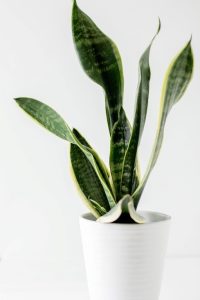
The Snake plant or Mother-In-Law’s Tongue is another air-purifying houseplant that you can grow in your home. This plant removes toxins like benzene, toluene, formaldehyde, and xylene from indoor air making it one of the best air-purifying houseplants for your bedroom. The Snake plant helps you sleep better at night by producing fresh oxygen.
Apart from its air-purifying qualities, the Snake plant is a resilient houseplant that survives with minimal attention. This plant thrives in bright indirect sunlight but can also survive in low-light conditions. The Snake plant is prone to root rot caused by overwatering. Only water your Snake plant when the soil is completely dry.
Aloe Vera plant
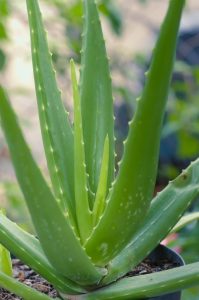
Aloe Vera is one of the best houseplants for purifying the air. This beautiful houseplant gets rid of toxins like benzene and formaldehyde present in paint, flooring finishes, and glue. Aloe Vera also removes carbon monoxide from indoor air and produces oxygen at night helping to improve your sleep.
Besides purifying the air, this plant is popular for its healing properties. Aloe Vera produces a sap that soothes burns and other skin irritations. This easy-going houseplant loves bright indirect sunlight and moderate watering to remain healthy. Water your plant lightly to prevent overwatering.
One of the downsides of the Aloe Vera plant is that it is toxic to pets. Place your plant in a spot that your pets cannot access.
Spider plant
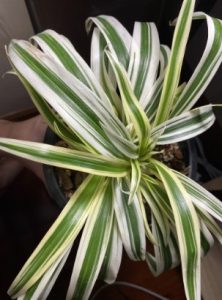
The Spider plant is an air-purifying houseplant that would be suitable for your bedroom. This attractive houseplant cleanses indoor air by removing pollutants such as xylene, carbon monoxide, benzene, and formaldehyde from indoor air. Spider plant is one of the best air-purifying houseplants safe for cats and dogs that you can freely grow around your pets.
This low-maintenance plant can tolerate various indoor growing conditions. Spider plants prefer bright indirect light to thrive. Direct sunlight will scorch your plant’s foliage. Water your Spider plant moderately and provide warm and humid conditions. Spider plants produce plantlets that you can use to propagate new plants.
Dragon Tree
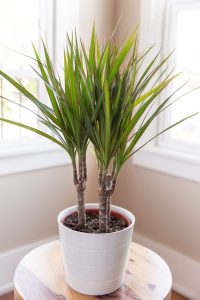
The Dragon Tree is one of the most resilient air-purifier houseplants that can help improve indoor air quality. This plant removes indoor pollutants like xylene and trichloroethylene from the air. The Dragon Tree adds color to your home with its colorful foliage.
This low-maintenance plant doesn’t need too much attention to thrive. The Dragon Tree does well in bright indirect sunlight. About 10 hours of sunlight daily would be ideal for your plant. Water your Dragon Tree when the top few inches of the soil become dry.
Try to use distilled water since the salts present in tap water can affect your Dragon tree. Dragon trees can grow as tall as 10 feet indoors and you should ensure you have enough space indoors. The ideal spot for a Dragon Tree would be in a spacious corner.
Chinese Evergreen plant
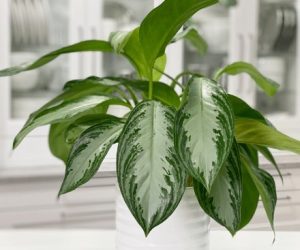
Chinese Evergreen is among the best houseplants that purify the air. This low-light plant improves indoor air quality by removing toxins present in detergents, glues, and cosmetics. Such toxins include formaldehyde, benzene, etc. This air-purifying houseplant also produces oxygen at night and helps you sleep better.
The Chinese evergreen plant would look great in a planter on the floor of your living room or bedroom. Your plant can thrive in bright indirect sunlight or shaded conditions. Water your plant occasionally to keep the soil moist but not soggy.
Chinese Evergreen is a high-humidity plant that flourishes in high-humidity areas like bathrooms. Regularly mist your plant’s leaves when the indoor environment becomes too dry.
Peace Lily plant
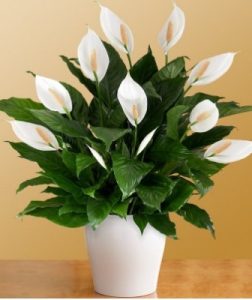
Besides its gorgeous flowers, the Peace Lily plant is commonly grown for its air-purifying qualities. This striking plant is one of the best air-purifying houseplants that gets rid of harmful indoor toxins like carbon monoxide and formaldehyde.
Peace Lily adds charm and elegance to your indoor space with its bold foliage and brightly colored blooms. To maintain its gorgeous appearance, water your Peace Lily regularly.
An under-watered Peace Lily develops brown or droopy leaves. Place your Peace lily in a location with bright filtered sunlight to encourage healthy growth. This plant is toxic to pets and you should consider placing it out of reach.
Pothos plant

Pothos, also known as Devil’s Ivy is a popular vining houseplant that trails gracefully along the edges of a hanging basket or planter. This lovely plant is also one of the best houseplants for purifying the air indoors. Pothos eliminates harmful allergens and toxins from indoor air while providing clean oxygen at night.
This unique houseplant can thrive in various indoor conditions. Pothos can tolerate low light conditions but would look its best in bright indirect sunlight. Allow the soil to partially dry out before watering your Pothos plant.
Use fast-draining soil to pot your plant to prevent waterlogging that might otherwise lead to root rot. Try to keep your Pothos plant away from your curious pets as it can be toxic when ingested.
Rubber Tree

The Rubber Tree is a resilient sustainable plant that can serve you for a long period. This plant is one of the air-purifying houseplants that you would be happy to grow indoors. The Rubber Tree absorbs harmful toxins from indoor air and produces oxygen at night. This plant has large glossy leaves that remove mold and bacteria from the air.
Growing a Rubber Tree indoors is quite easy under ideal conditions. This beginner-friendly plant is drought-resistant and can tolerate neglect. Water your plant when the soil becomes completely dry. Avoid overwatering your rubber plant as it can develop root rot and die.
The Rubber plant can survive in a dimly lit room. However, for the best results, place your plant near a window that receives bright indirect sunlight. Ensure you have ample space to grow a Rubber tree indoors since it can grow up to 8 feet tall.
Areca Palm plant

If you want to add a tropical feel to your home, growing an Areca Palm plant would be the perfect solution. This plant is also among the best air-purifier plants that promote healthy living by eliminating harmful toxins from the air. Areca Palm plant absorbs and breaks down pollutants such as benzene, toluene, and formaldehyde from indoor air.
This beautiful houseplant has unique foliage that adds a touch of elegance and class to your indoor space. Caring for an Areca Palm plant is relatively easy under the right growing conditions. To keep your plant looking healthy, water it regularly such that the soil is lightly moist. Fluoride and chlorine present in tap water can affect your plant.
Try to use distilled water when watering your Areca Palm plant. The Areca plant also loves bright indirect sunlight. The ideal spot to place your plant is near a south-facing window.
Protect your plant from bright direct sunlight using curtain sheers. The Areca Palm is among the non-toxic air-purifying houseplants safe for cats. You don’t have to worry about growing your Areca Palm around your pets or children.
Houseplants that purify the air create a healthy indoor environment by eliminating harmful toxins. Some of the best air-purifying houseplants include Aloe Vera, Pothos, Dragon Tree, Peace Lily, and others. Besides purifying indoor air, these plants add natural splendor to your space with their beautiful foliage. If you constantly suffer from allergies, growing air-purifier houseplants can be helpful. If you require more information, don’t hesitate to contact us today.
